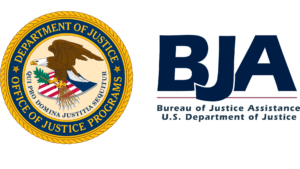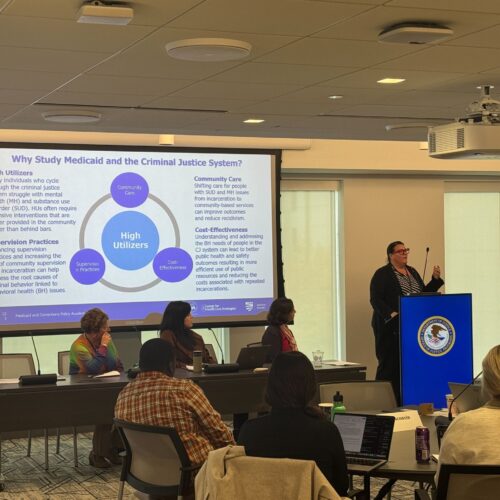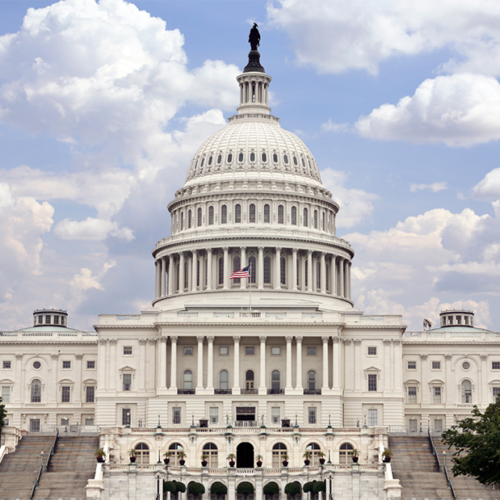What Correctional Agencies Need to Know about the Medicaid Section 1115 Reentry Demonstration Opportunity
When authorized in 1965, Medicaid was prohibited by Congress from allowing payments for services provided to “inmates of a public institution.” As a result, corrections leaders have utilized other state and federal opportunities to finance health care services for people who are incarcerated and upon their release back into communities. However, in 2023, the Centers for Medicare & Medicaid Services (CMS) developed new guidance based on the Substance Use-Disorder Prevention that Promotes Opioid Recovery and Treatment for Patients and Communities (SUPPORT) Act. This brief provides key information to corrections leaders about the Medicaid Section 1115 Reentry Demonstration Opportunity, which allows states to provide critical pre- and post-release care for people returning to their communities from incarceration.
Medicaid Section 1115 Reentry Demonstration Opportunity: What Is It?
When authorized in 1965, Medicaid was prohibited by Congress from allowing payments for services provided to “inmates of a public institution.”1 As a result, corrections leaders have utilized other state and federal opportunities to finance health care services for people who are incarcerated and upon their release back into communities. However, in 2023, the Centers for Medicare & Medicaid Services (CMS) developed new guidance based on a statutory requirement in Section 5032 of the Substance Use-Disorder Prevention that Promotes Opioid Recovery and Treatment for Patients and Communities Act (SUPPORT Act) (Pub. L. No. 115-271). This new guidance, published in April 2023, allowed for a new opportunity for states to provide reimbursement for certain Medicaid services for up to 90 days before release for people who are incarcerated.
Here are the high points:
- The Medicaid Section 1115 Reentry Demonstration Opportunity focuses on improving care transitions and reentry outcomes for eligible people leaving correctional facilities.2
- Medicaid Section 1115 demonstration projects, sometimes called “1115 waivers,” give states flexibility to pilot new approaches to improve their state’s Medicaid program and better serve Medicaid-eligible individuals. States can apply to use the Section 1115 demonstration authority to address eligibility, benefits, and delivery systems in ways that would otherwise not be allowed under Medicaid.
- State Medicaid agencies must apply for this demonstration opportunity and receive approval from CMS to access federal Medicaid funding for the populations and services defined in the application.
Opportunities for Corrections Systems
The Medicaid Section 1115 Reentry Demonstration Opportunity provides critical pre-release resources for physical and behavioral health care in corrections settings for up to 90 days before release and for pre- and post-release care management to promote individuals’ seamless transitions into the community. The ability to leverage Medicaid for these services means new opportunities for state and local corrections agencies to partner with state Medicaid agencies, other criminal justice system stakeholders, physical and behavioral health agencies, and community partners to design and implement coordinated reentry best practices. Potential benefits of these opportunities include:
Improving health
People in correctional facilities have significantly higher rates of chronic physical and behavioral health conditions and infectious diseases than the general population.3 There is also an increased risk of suicide attempts among people transitioning from prison, particularly older adults.4 A strong connection to care can improve health outcomes, support recovery, and reduce recidivism.
Supporting recovery
The U.S. Department of Justice estimates that more than half of individuals in state prisons and about two-thirds of individuals sentenced in jails have substance use disorders.5 During reentry, individuals with opioid use disorder are at greatest risk of death and overdose immediately following release from jail or prison.6 However, medication-assisted treatment (MAT) has been shown to reduce the risk of overdose death by up to 75 percent.7 This new Medicaid Section 1115 Reentry Demonstration Opportunity can support corrections in coordinating life-saving pre-release services by addressing behavioral and physical health needs through case management, ensuring continuity of clinically appropriate MAT, and providing a 30-day supply of prescription medications upon release.
Reinvesting in health care
In order to receive approval for a Medicaid Section 1115 Reentry Demonstration, a state must agree to reinvest the total amount of federal matching funds received for previously funded existing carceral care services into activities or initiatives that improve access to and quality of health care and health-related social services for those who are incarcerated or recently released. States are required to develop a reinvestment plan, as part of the implementation plan, outlining how federal matching funds received under the demonstration will be reinvested. Examples of reinvestments include improved access to behavioral health and physical health services in the community, improved health information technology and data sharing, or increased community-based provider capacity to serve individuals who are involved in the justice system or at risk of justice system involvement.
Enhancing eligibility, enrollment, and services
People who are incarcerated remain eligible for Medicaid. However, some states terminate Medicaid eligibility for individuals who become incarcerated. The demonstration requires that states suspend, not terminate, Medicaid eligibility during incarceration, which is important for continuity of coverage when people are released. States will have up to two years to fully implement a suspension process. The demonstration also allows states to realize opportunities to provide certain Medicaid services to eligible populations before release and to improve linkage to needed care and care coordination. State Medicaid agencies are encouraged to work with correctional partners to plan demonstration strategies for Medicaid application and enrollment; develop processes for information sharing, data sharing, and coordinated case management; and increase the availability of services, such as MAT, prior to release.
Beginning in 2026, all states are required under the Consolidated Appropriations Act of 2024 to establish a plan to suspend, not terminate, Medicaid coverage for both adults and youth who are incarcerated and to ensure coverage is reactivated on release.8
Developing partnerships
By developing partnerships with the state Medicaid agency, corrections systems can advance cross-system communication and collaboration to share information, connect people with the services they need during incarceration and after release, and improve health outcomes through expanded services while potentially reducing costs through Medicaid. This includes but is not limited to health information technology capacity to collect health data and to access or share information with state Medicaid agencies.
As of July 2024, California, Illinois, Kentucky, Massachusetts, Montana, New Hampshire, New Mexico, Oregon, Utah, Vermont, and Washington have approved Medicaid Section 1115 Reentry Demonstrations, and at least 13 other states have submitted demonstration proposals.9
Goals of the Medicaid Section 1115 Reentry Demonstration Opportunity
States developing Medicaid Section 1115 Reentry Demonstration Opportunity applications should consider the goals CMS has outlined to guide their objectives:
- Increase health coverage, continuity of coverage, and appropriate service uptake for people who are involved in the justice system.
- Improve access to services prior to release and improve transitions and continuity of care into the community upon release and during reentry.
- Improve coordination and communication between corrections settings, Medicaid systems, and community-based care providers.
- Increase additional investments in health care and related services.
- Reduce deaths and the use of emergency department and inpatient care.10
What Correctional Facilities Are Eligible to Participate
in a State’s Demonstration?
- States can choose which types of correctional settings to include in their demonstration, including state prisons, local jails, Tribal correctional facilities, and youth correctional facilities. States also have the option to limit demonstration participation to specific, individual correctional facilities.
- States may take a phased approach to adding correctional facilities throughout the life of the proposed demonstration.
Who Can Apply for the Demonstration?
- State Medicaid agencies in all states, the District of Columbia, and territories are eligible to apply for the Medicaid Section 1115 Reentry Demonstration Opportunity.
- States may apply for a Medicaid Section 1115 Reentry Demonstration Opportunity whether or not they have expanded access to Medicaid coverage for low-income adults under the Patient Protection and Affordable Care Act (2010).
Who Is Eligible to Receive Services under an Approved Demonstration?
- CMS encourages states to broadly define the demonstration population to include otherwise eligible, soon-to-be released people who are incarcerated.
- States may propose including all Medicaid-eligible people in participating correctional settings.
- Alternatively, states have the flexibility to customize the population(s) covered by the demonstration and limit, for example, to people with specific conditions, such as people with serious mental illness, substance use disorder, or chronic conditions or older people.
What Services Are Covered?
CMS provides parameters for an expected minimum set of services to be provided during the pre-release period. States can decide to apply for an expanded set of services,11 but CMS generally expects that a demonstration will need to cover at least the following three pre-release benefits to be likely to succeed in improving care transitions upon reentry:
- Case management to identify health and health-related social needs of people who are preparing to leave jail or prison, develop a specific care plan based on those needs, make referrals and connections to care, and monitor activities to ensure the needs on the care plan are adequately addressed.
- MAT for substance use disorders as clinically appropriate. MAT includes medication in combination with counseling or behavioral therapies.
- A 30-day supply of all prescription medications provided to individuals at release.
For all pre-release services, state Medicaid and corrections agencies should collaboratively decide how community-based providers can facilitate the services in facilities or how corrections staff or correctional health providers can provide the services in coordination with community-based providers.
What Can My Correctional Agency Do Next?
Corrections leaders should determine whether their state has applied for a Medicaid Section 1115 Reentry Demonstration and reach out to their state’s Medicaid director to begin or continue the discussion about these new opportunities for their state:
- If your state has an approved or submitted application, you can check with your state’s Medicaid agency to confirm the status of the application and begin or continue discussions to develop a shared vision for how the opportunity could meet public safety and health goals.
- If you are not sure whether your state Medicaid agency has applied, you can consult with your state’s Medicaid agency to determine your state’s application status or the CMS website.
- If your state has not applied, corrections can initiate a discussion about developing a demonstration in partnership with the Medicaid director. In addition, you could consider working with your state’s corrections association to host open discussions about how a demonstration may be beneficial for your state.
Whether or not your state has applied for the Medicaid Section 1115 Reentry Demonstration Opportunity, corrections leaders should partner with Medicaid leaders. By building relationships with Medicaid leaders, corrections leaders can assess opportunities to improve Medicaid eligibility and enrollment practices, learn how to better partner with Medicaid-participating providers, explore opportunities to share data and information to improve health outcomes and reduce recidivism, identify opportunities for pilot projects, and develop a shared vision beyond a demonstration application.
National Association of Medicaid Directors
You can identify your state Medicaid director by visiting the National Association of Medicaid Directors website, which lists Medicaid directors by state.
Future Planning Topics for Corrections and Medicaid Stakeholders
State Medicaid agencies have the authority to determine how wide or narrow the eligible population is for pre-release services and which correctional agencies will participate as part of the opportunity, subject to approval by CMS. Corrections partners should think through the best way to use this opportunity and make recommendations to state Medicaid agencies on the eligible population. Together, corrections and Medicaid partners should determine the service needs of the eligible population.
Corrections agencies can also identify the strengths of their systems and prepare to share where they see opportunities for the demonstration to support needed practice and policy changes. Take stock of existing efforts and capabilities within your system. These will be critical assets for planning and in later stages. Helpful information for a Medicaid partnership may include the following:
- Current physical and behavioral health services, including substance use and mental health treatment, provided in your corrections system
- Existing policies and experience with screening for Medicaid eligibility and other benefits
- Reentry policies and procedures and case management processes and partnerships
- Use of medications within the correctional facility, including medication for substance use disorders (including opioid use disorder) and take-home doses or prescriptions provided to people when they are released
- Relationships with community-based providers
- Opportunities for reinvestments to improve access to health care
- Surveys of people who are in reentry or who have reentered their community to determine the most needed connections and services
- Current health information technology capacity to collect health data and to access or share information with state Medicaid agencies. Medicaid reactivation and enrollment efforts, as well as links to services and care, will require data sharing and coordination between pre- and post-release care management.
This project was supported by Grant No. 15PBJA-23-GK-05504-MUMU awarded by the Bureau of Justice Assistance. The Bureau of Justice Assistance is a component of the Department of Justice’s Office of Justice Programs, which also includes the Bureau of Justice Statistics, the National Institute of Justice, the Office of Juvenile Justice and Delinquency Prevention, the Office for Victims of Crime, and the Office of Sex Offender Sentencing, Monitoring, Apprehending, Registering, and Tracking. Points of view or opinions in this document are those of the author and do not necessarily represent the official position or policies of the U.S. Department of Justice.


Endnotes
1. Social Security Act, 42 U.S.C. 1396d §1905(a)(32)(A), https://uscode.house.gov/view.xhtmlhl=false&edition=prelim&req=granuleid%3AUSC-prelim-title42-section1396d.
2. Centers for Medicare & Medicaid Services (CMS), State Medicaid Director Letter #23-003, Opportunities to Test Transition-Related Strategies to Support Community Reentry and Improve Care Transitions for Individuals Who Are Incarcerated (Baltimore: U.S. Department of Health and Human Services, April 17, 2023), https://www.medicaid.gov/sites/default/files/2023-04/smd23003.pdf.
3. CMS, State Medicaid Director Letter #23-003.
4. Lisa C. Barry et al., “Increased Risk of Suicide Attempts and Unintended Death among Those Transitioning From Prison to Community in Later Life,” American Association for Geriatric Psychiatry 26, no. 11 (2018): 1165–1174, https://pubmed.ncbi.nlm.nih.gov/30146371/.
5. Jennifer Bronson, Jessica Stroop, Stephanie Zimmer, and Marcus Berzofsky, Drug Use, Dependence, and Abuse among State Prisoners and Jail Inmates, 2007-2009 (Washington, DC: Bureau of Justice Statistics, 2017), https://bjs.ojp.gov/content/pub/pdf/dudaspji0709.pdf.
6. Ingrid A. Binswanger et al., “Release from Prison—A High Risk of Death for Former Inmates,” The New England Journal of Medicine 356, no. 2 (2007): 536, https://doi.org/10.1056/nejmsa064115.
7. Louisa Degenhardt et al., “The Impact of Opioid Substitution Therapy on Mortality Post-Release from Prison: Retrospective Data Linkage Study,” Addiction 109, no. 8 (2014): 1306-17, https://pubmed.ncbi.nlm.nih.gov/24612249/.
8. H.R.4366 – Consolidated Appropriations Act, 2024, Pub. L. No. 118-42 (2024), https://www.congress.gov/118/bills/hr4366/BILLS-118hr4366enr.pdf.
9. As of July 2024, the Centers for Medicare & Medicaid Services has approved Medicaid Section 1115 Reentry Demonstrations in California, Illinois, Kentucky, New Hampshire, New Mexico, Massachusetts, Montana, Oregon, Utah, Vermont, and Washington State. States with a pending Medicaid Section 1115 Reentry Demonstration for people involved in the justice system include Arizona, Arkansas, Colorado, Connecticut, District of Columbia, Hawaii, Maryland, New Jersey, New York, North Carolina, Pennsylvania, Rhode Island, and West Virginia. See “Medicaid Waiver Tracker: Approved and Pending Section 1115 Waivers by State,” KFF (formerly Kaiser Family Foundation), https://www.kff.org/medicaid/issue-brief/medicaid-waiver-tracker-approved-and-pending-section-1115-waivers-by-state/.
10. CMS, State Medicaid Director Letter #23-003.
11. CMS, State Medicaid Director Letter #23-003, pages 24-26.
Project Credits
Writing: Liz Buck and Andrew Spencer, Center for Health Care Strategies; Amy Button and Sarah Wurzburg, CSG Justice Center
Research: Liz Buck and Andrew Spencer, Center for Health Care Strategies; Amy Button and Sarah Wurzburg, CSG Justice Center
Advising: Sarah Wurzburg, CSG Justice Center
Editing: Alice Oh, CSG Justice Center
Design: Michael Bierman
Web Development: Yewande Ojo, CSG Justice Center
Public Affairs: Jen Wilburne, CSG Justice Center


When returning to their communities from criminal justice settings, people with behavioral health needs face barriers in accessing…
Read MoreNew Hampshire Department of Corrections Commissioner Helen Hanks presents at the Medicaid and Corrections Policy Academy in-person meeting.
Read MoreThe Council of State Governments (CSG) Justice Center has launched the Collaborating for Youth and Public Safety Initiative…
Read More Assigned to the Cloud Crew: The National Incarceration Association’s Hybrid Case Management for People with Behavioral Health Needs
Assigned to the Cloud Crew: The National Incarceration Association’s Hybrid Case Management for People with Behavioral Health Needs
When returning to their communities from criminal justice settings, people with behavioral…
Read More Meet the Medicaid and Corrections Policy Academy Mentor States
Meet the Medicaid and Corrections Policy Academy Mentor States
New Hampshire Department of Corrections Commissioner Helen Hanks presents at the Medicaid…
Read More Six States Commit to Improving Statewide Strategies to Address Youth Crime, Violence and Behavioral Health
Six States Commit to Improving Statewide Strategies to Address Youth Crime, Violence and Behavioral Health
The Council of State Governments (CSG) Justice Center has launched the Collaborating…
Read More Bipartisan Group of 88 Lawmakers Push for Continued Funding for Reentry and Recidivism Programs
Bipartisan Group of 88 Lawmakers Push for Continued Funding for Reentry and Recidivism Programs
A bipartisan group of 88 lawmakers, led by Representatives Carol Miller (R-WV)…
Read More










